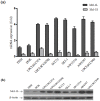Overexpression of Mcl-1L splice variant is associated with poor prognosis and chemoresistance in oral cancers
- PMID: 25409302
- PMCID: PMC4237324
- DOI: 10.1371/journal.pone.0111927
Overexpression of Mcl-1L splice variant is associated with poor prognosis and chemoresistance in oral cancers
Abstract
Background: Altered expression of Mcl-1, an anti-apoptotic member of the Bcl-2 family, has been linked to the progression and outcome of a variety of malignancies. We have previously reported the overexpression of Mcl-1 protein in human oral cancers. The present study aimed to evaluate the clinicopathological significance of the expression of three known Mcl-1 isoforms in oral tumors and the effect of targeting Mcl-1L isoform on chemosensitivity of oral cancer cells.
Methods: The expression of Mcl-1 isoforms- Mcl-1L, Mcl-1S & Mcl-1ES was analyzed in 130 paired oral tumors and 9 oral cell lines using quantitative real-time PCR & protein by western blotting. The Mcl-1 mRNA levels were correlated with clinicopathological parameters and outcome of oral cancer patients. The effect of Mcl-1L shRNA or Obatoclax (a small molecule Mcl-1 inhibitor), in combination with Cisplatin on chemosensitivity of oral cancer cells was also assessed.
Results: Anti-apoptotic Mcl-1L was predominantly expressed, over low or undetectable pro-apoptotic Mcl-1S and Mcl-1ES isoforms. The Mcl-1L transcripts were significantly overexpressed in all cancer cell lines and in 64% oral tumors versus adjacent normals (P<0.02). In oral cancer patients, high Mcl-1L expression was significantly associated with node positivity (P = 0.021), advanced tumor size (P = 0.013) and poor overall survival (P = 0.002). Multivariate analysis indicated Mcl-1L to be an independent prognostic factor for oral cancers (P = 0.037). Mcl-1L shRNA knockdown or its inhibition by Obatoclax in combination with Cisplatin synergistically reduced viability and growth of oral cancer cells than either treatment alone.
Conclusion: Our studies suggest that overexpression of Mcl-1L is associated with poor prognosis and chemoresistance in oral cancers. Mcl-1L is an independent prognostic factor and a potential therapeutic target in oral cancers.
Conflict of interest statement
Figures






Similar articles
-
Tipping the balance of cell death: alternative splicing as a source of MCL-1S in cancer.Cell Death Dis. 2024 Dec 18;15(12):917. doi: 10.1038/s41419-024-07307-z. Cell Death Dis. 2024. PMID: 39695189 Free PMC article. Review.
-
Association of anti-apoptotic Mcl-1L isoform expression with radioresistance of oral squamous carcinoma cells.Radiat Oncol. 2012 Aug 8;7:135. doi: 10.1186/1748-717X-7-135. Radiat Oncol. 2012. PMID: 22873792 Free PMC article.
-
[Role of overexpression of myeloid cell leukemia-1-long in prognosis of malignant pleomorphic adenoma].Zhonghua Kou Qiang Yi Xue Za Zhi. 2020 Mar 9;55(3):153-158. doi: 10.3760/cma.j.issn.1002-0098.2020.03.002. Zhonghua Kou Qiang Yi Xue Za Zhi. 2020. PMID: 32193910 Chinese.
-
Human oral cancers have altered expression of Bcl-2 family members and increased expression of the anti-apoptotic splice variant of Mcl-1.J Pathol. 2009 Feb;217(3):398-407. doi: 10.1002/path.2459. J Pathol. 2009. PMID: 19009587
-
Mcl-1 targeting could be an intriguing perspective to cure cancer.J Cell Physiol. 2018 Nov;233(11):8482-8498. doi: 10.1002/jcp.26786. Epub 2018 May 24. J Cell Physiol. 2018. PMID: 29797573 Review.
Cited by
-
Alternative-splicing defects in cancer: Splicing regulators and their downstream targets, guiding the way to novel cancer therapeutics.Wiley Interdiscip Rev RNA. 2018 Jul;9(4):e1476. doi: 10.1002/wrna.1476. Epub 2018 Apr 25. Wiley Interdiscip Rev RNA. 2018. PMID: 29693319 Free PMC article. Review.
-
Methotrexate-coupled nanoparticles and magnetic nanochemothermia for the relapse-free treatment of T24 bladder tumors.Int J Nanomedicine. 2017 Apr 6;12:2793-2811. doi: 10.2147/IJN.S120969. eCollection 2017. Int J Nanomedicine. 2017. PMID: 28435259 Free PMC article.
-
Histone Deacetylase Inhibitor Enhances the Efficacy of MEK Inhibitor through NOXA-Mediated MCL1 Degradation in Triple-Negative and Inflammatory Breast Cancer.Clin Cancer Res. 2017 Aug 15;23(16):4780-4792. doi: 10.1158/1078-0432.CCR-16-2622. Epub 2017 May 2. Clin Cancer Res. 2017. PMID: 28465444 Free PMC article.
-
Tipping the balance of cell death: alternative splicing as a source of MCL-1S in cancer.Cell Death Dis. 2024 Dec 18;15(12):917. doi: 10.1038/s41419-024-07307-z. Cell Death Dis. 2024. PMID: 39695189 Free PMC article. Review.
-
Myeloid cell leukemia-1: a formidable barrier to anticancer therapeutics and the quest of targeting it.Explor Target Antitumor Ther. 2022;3(3):278-296. doi: 10.37349/etat.2022.00083. Epub 2022 May 24. Explor Target Antitumor Ther. 2022. PMID: 36045907 Free PMC article. Review.
References
-
- Dikshit R, Gupta PC, Ramasundarahettige C, Gajalakshmi V, Aleksandrowicz L, et al. (2012) Cancer mortality in India: a nationally representative survey. Lancet 379: 1807–1816. - PubMed
-
- Reed JC (1999) Dysregulation of apoptosis in cancer. Journal of Clinical Oncology 17: 2941–2941. - PubMed
-
- Cory S, Adams JM (2002) The Bcl2 family: regulators of the cellular life-or-death switch. Nature Reviews Cancer 2: 647–656. - PubMed
-
- Craig R (2002) MCL1 provides a window on the role of the BCL2 family in cell proliferation, differentiation and tumorigenesis. Leukemia: official journal of the Leukemia Society of America, Leukemia Research Fund, UK 16: 444. - PubMed
MeSH terms
Substances
LinkOut - more resources
Full Text Sources
Other Literature Sources
Medical

